

 |
||||||||||||||||||
 |
||||||||||||||||||
|
||||||||||||||||||
Awards: Best Binoculars 2024 (Under $1000 / £1000 / €)
Whilst a relatively new name in the world of optics, Maven has in my experience climbed the ladder very fast and now (in terms of the performance and quality to price ratio) offer some of the very best binoculars currently available.
A good example of this is shown by the fact that two models that I have reviewed in the past have gone on to win awards for the year I tested them, the Maven B5 18x56, the best high power bino and the Maven B2 11x45, the overall winner as binocular of the year.
What I also like about Maven Outdoor Equipment Company is that they have not at all rested on their laurels and to me they seem to be almost continuously refining and adapting their instruments looking for improvements. So when they contacted me with the information that they had developed and were soon releasing some new models into their expanding range it was no surprise and I was obviously was very interested to try them out as soon as possible and so we arranged to have a couple of pairs sent out for me to test:
Assembled in the US using Japanese made components and available in either an 8x42 or 10x42 configuration, the new B1.2 series is as the name suggests: an update to their popular premium level, flagship B.1 binoculars. A quick look at the specifications and features indicates that they have been improved in a number of areas (like smaller size, lower weight, better optical coatings and wider views which I will highlight later in this review), but what is also impressive is that at the same time Maven Sport Optics has not increased them in price, meaning that as good as the B1 was, the B.1.2 has the potential to offer even more "bang for your buck"!
Thus all sounds super in theory and for marketing purposes, but how does this all wash out in practice I hear you ask? Well below are my completely honest thoughts and opinions after having tested, compared and used the 10x42 Maven B1.2 binoculars over a period of around four weeks:
Specs & Features at a Glance:
Shape
As you would expect, both the 10x42 and the 8x42 Maven B1.2 binoculars use the same chassis and many of the outer parts used are the same and this part of the review will apply equally to both:
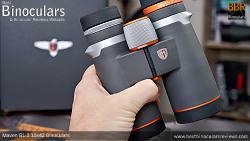 With its distinctive gray and orange color scheme, the B1.2 series is almost instantly recognizable as being from Maven in that they also sport a single, top-hinge design that they use on many of their other instruments and which has become a popular choice of many modern higher-end roof prism binoculars.
With its distinctive gray and orange color scheme, the B1.2 series is almost instantly recognizable as being from Maven in that they also sport a single, top-hinge design that they use on many of their other instruments and which has become a popular choice of many modern higher-end roof prism binoculars.
Measuring 3.1cm wide, the bridge is relatively thin, meaning that compared to the double hinge design or even a single hinge with a wider bridge, these I suppose are technically less structurally sound and there would be more of a chance for the barrels to become misaligned should you drop or mishandle the bino.
However, without testing it to destruction, I found the bridge on my sample to "feel" more than strong enough to handle normal use and the occasional bang and thus this would not be something that I would be overly concerned with on these unless you are really going to be putting your binos through the mill ... which you really shouldn't anyway!
On the plus side, the thinner bridge in theory will be more lightweight than those that use more of the same material to make a thicker one and it also exposes more of the barrels for you to grab onto. This is a not often mentioned feature that I always appreciate as I will frequently use my binoculars without a neck strap and just carry them about in my hands and thus having a large and secure area to hold becomes significant.
IPD (Inter-Pupillary Distance) Adjustment
To adjust the distance between the eye pieces to match that of your eyes, as always you simply open and close the hinge, which is easy enough, but importantly they have what I would describe as the idea level of resistance allowing them to remain at your desired setting. An overly tight hinge is not ideal, but a very loose one that you continuously have to open up to your eyes becomes extremely annoying very quickly.
Also important to mention is that the IPD (Inter-Pupillary Distance) range on these 42mm Maven B1.2 binoculars takes you from 5.6cm up to a maximum of 7.4cm which for a 42mm roof prism binocular is pretty normal. Note here that the older Maven B.1 binoculars had a very slightly narrower range of 5.6 to 7.3cm.
Exterior Rubber Coating
The exterior rubber coating on these Maven B1.2 10x42 binoculars is very similar, if not identical to that which is used on all the other Maven binoculars that I have tested, which for the most part is a good thing:
Firstly it fits very tightly onto the chassis underneath and thus does not move or slip about at all.
The rubber is very thin and quite hard and thus will not provide as much impact protection as those that use thicker, softer rubber armors.
By itself this thin hard rubber would result in a pretty low grip surface, but due to the very fine, almost velvet like texture imprinted into it, I found the the "grippiness" (is that a word?) of the rubber to be excellent on this and all other Maven binoculars.
On top of this, this fine texture also makes the surface a little less reflective, which if stealthiness is important to you, can certainly be a consideration to keep in mind. Although, having said that the uncovered metal details like the rings near the eyepiece and the shiny focus wheel do negate this advantage somewhat.
Chassis
Whilst certainly not as lightweight, another nod to the superior quality of this instrument is the use of a chassis made from magnesium alloy and not a polycarbonate plastic that I see more and more these days.
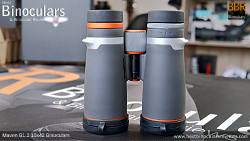 Not only does a metal chassis have the potential to be more robust (not always the case, depending on the design), but I have read that magnesium has an excellent resistance to temperature related expansion and contraction and thus it will help prevent any misalignment of the optics due to to extreme temperatures: Be that from the natural environment or indeed if you were to do something like accidentally leave your set in the car on a hot sunny day for example. Note: even with a magnesium chassis, I would strongly recommend against doing this as it can also negatively affect the rubber coatings and the glue used to secure it to the chassis.
Not only does a metal chassis have the potential to be more robust (not always the case, depending on the design), but I have read that magnesium has an excellent resistance to temperature related expansion and contraction and thus it will help prevent any misalignment of the optics due to to extreme temperatures: Be that from the natural environment or indeed if you were to do something like accidentally leave your set in the car on a hot sunny day for example. Note: even with a magnesium chassis, I would strongly recommend against doing this as it can also negatively affect the rubber coatings and the glue used to secure it to the chassis.
Fully Sealed
As with the B1, these Maven B1.2 10x42 binoculars have a IPX7 rating meaning they have seals that are designed to remain watertight at a depth of 1 meter for at least 30 minutes, which should cover most "normal" uses and easily be sufficient to prevent water entering in even the wettest conditions.
Also keep in mind that these seals are important for preventing dust from entering, which can happen in dry areas as well as during storage in the home.
Fog Proofing
During manufacture, Maven also removes the air from the interior and replaces it with a moistureless nitrogen gas which prevents fogging (small water droplets) from forming on the internal lens surfaces which can easily occur on an unprotected instrument when there is a rapid temperature change (like when you first leave the house on a cold winter morning).
Eye-Cups & Eyepieces
Another definite sign of quality I see on these Maven B1.2 binoculars is that the eyepiece and eyecup housings are made from metal (probably aluminum) and not plastic as which is often the case on lesser instruments.
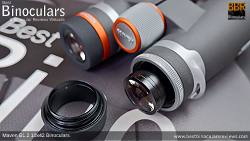 Like the chassis, the negative of this is that this will certainly increase the overall weight, but as this is the part of a binocular that gets damaged most often if you drop them, this is important. Another aspect that I really like is that the eyecups can be unscrewed and removed. This is a feature you only find on more expensive instruments and it not only allows you to replace them if needed, but also really helps when you do a better job when you need to clean the ocular lenses.
Like the chassis, the negative of this is that this will certainly increase the overall weight, but as this is the part of a binocular that gets damaged most often if you drop them, this is important. Another aspect that I really like is that the eyecups can be unscrewed and removed. This is a feature you only find on more expensive instruments and it not only allows you to replace them if needed, but also really helps when you do a better job when you need to clean the ocular lenses.
The rubber padding on each eyecup is like the body armor: thin and pretty hard. This means they are not the most comfortable cups I have ever come across, they are not uncomfortable to use either.
Also on the positive, they are attached very firmly to the metal chassis underneath and this type of rubber is in my experience longer lasting and more robust than thick soft rubbers as it is far less likely to move about or perish.
As with the build quality and quality of materials used (or because of it), the twist-up mechanism on the eyecups is also very good. The cups click nice and positively into each of the click stops. Of which there are a total of four: Maximum, Minimum and two intermediate settings. This along with the long eye-relief (17.8mm) is excellent as most 10x42 binoculars only have three stops and less eye-relief meaning these just give you more options and more room to work with thus enabling you to get the perfect setting for you and your shape of face even when wearing glasses.
The only slight issue I have is that the amount of resistance to movement is a little on the light side and thus it is possible in some positions to accidentally push the eye-cups down if you press you face to firmly against them. Although having said this, I just tested it again and you do have to push pretty hard and it would not be something you would do naturally.
What it does mean though is you cant really position the eyecups in between the click stops and have them reliably stay at that setting. Although once again because there are 4 fixed stops, the likelihood that you would want or nee to do this is very small.
Focus Wheel & Focussing
As far as I can tell, the new Maven B1.2 10x42 binoculars use the same focus wheel as that I have come across on all their other instruments that I have thus far reviewed, which to my mind is great news as it is one of my favorite (if not THE favorite) focus wheels of any binocular I have used.
Firstly unlike many, many binos, including some "alpha" level ones (Swarovski comes to mind), Maven has gone with metal and not plastic for the main material. Sure I will admit that in terms of the strength needed, this is probably an overkill, but it just looks, feels and certainly in this case simply works much better than the average plastic focus wheel.
The wheel is also fairly large (31mm diameter & 28mm long) and perfectly positioned which for my "average" sized hands makes it very easy and natural to reach from the standard grip when holding the bino up to your eyes.
Then there is the deeply etched surface on the outer surface of the wheel that delivers an unmatched level of grip. During normal day-to-day use, this may seem little more than a nice feature, but in winter when wearing thick gloves, this along with the size and "sitting up proud" position really does help make finding the wheel and making rapid an accurate focal adjustments much easier to do.
Then as always with the Maven binoculars I have come across, I found that the actual focus mechanism on my sample to be extremely smooth throughout the whole range, which once again certainly assists you in achieving fast and accurate focal adjustments.
In terms of the gearing, on my 10x42 sample, it took 2 full turns (720°) to go from one extreme to the other. This is what I would describe as being a fairly neutral and thus a good all-rounder (More aggressive gearing makes it quicker to make large focal adjustments, but is more difficult to make fine adjustments, whilst the opposite makes fine tuning easier and more accurate, but take longer to make large changes).
Lastly, I also like the Maven stamped faceplate on the rear of the wheel and the fact that it does not turn with the wheel, to my tastes is just cool (I can see my daughter cringing now!). But to sum up, with the Maven B1.2 10x42 binoculars I had nothing but a great focusing experience using a wheel that is about as far as you could get from the generic, plastic ones I see used on many modern instruments.
As with the eyecups and focus wheel the diopter adjustment ring is made from metal and whist not strictly necessary, it just feels and looks better than the many, many plastic ones out there.
For those who don't know, the diopter is used to calibrating the binocular to your particular vision as it allows you to offset the focus on the right side independently of the left which in turn means you can compensate for any differences between your left and right eyes.
Once you have made this adjustment, you really don't need to do it again (unless you share your binoculars, or your eyesight changes) and thus in my opinion, a good diopter should remain at your desired setting without the chance of being moved by accident and if you need to (like if you share your instrument) you should be able to easily return it to a particular setting.
Some high-end binoculars have a lockable diopter which is ideal. The diopter ring on the Maven B1.2 binocular isn't, but it is relatively thin, has a tight mechanism and is fairly inconspicuous, all of which help prevent unintentional movement which is good.
In terms of markings, there really only is the neutral marker and a + and - sigh to work with and thus if you have a particular setting that doesn't line up with any of these, I would suggest making a small mark with a permanent market or a small nick with a sharp knife.
One aspect that is truly excellent on these is that they have a diopter correction range (dpt) of +/-5 which is the largest amount I have ever come across (usually it is +/-2 and I consider good to be +/-3) and thus these could make for an excellent choice should you have one eye that is far more dominant than the other.
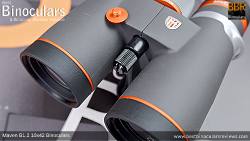 Tripod Adaptable
Tripod Adaptable
It is very easy to attach the Maven B1.2 binocular to a tripod/monopod using an ordinary tripod adapter.
You simply unscrew the cap on the front face of the hinge and then screw in the adapter and attach it onto your tripod head. The gap between the barrels at the narrowest point with the lens covers attached is 1.7cm, which is something to keep in mind when selecting an adapter, just to make sure it can fit in between the gap.
Body Quality Score: 9/10
Weight
Whilst by no means the lightest, for a high end 42mm binocular with so many metal parts, the relatively low weight of the Maven B1.2 10x42 binoculars is not at all bad and they compare very well to other similar sized instruments at this quality level (see table below).
Also note that at 29.75oz, the Maven B1 10x42 binoculars were/are quite a lot heavier than the updated B1.2.
Dimensions
One aspect that immediately struck me as I took them out the packaging for the first time was how compact they seemed to me.
In terms of the width and depth they are pretty standard, but the length of them is quite a lot shorter than lot of 10x42 binoculars and this is another area where the B1.2 differs quite a lot from the B1, which has a length of 6.2in.
Body Stats Score (for a 42mm binocular): 9/10
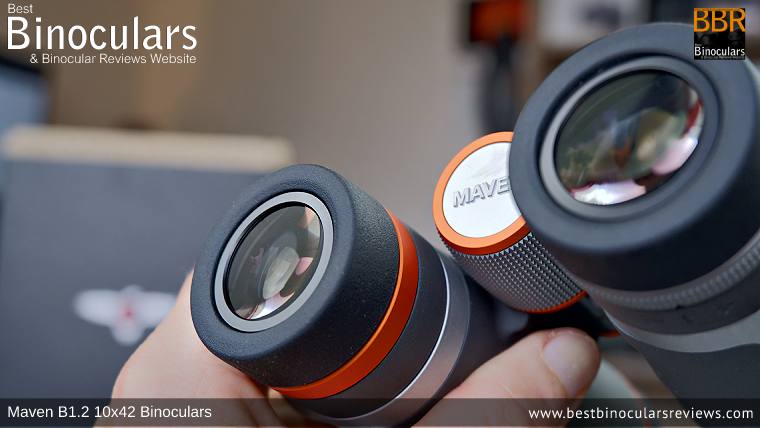
Each ocular lens on these Maven B1.2 10x42 binoculars consists of 6 elements arranged into 4 groups and I measured the outermost element to have a diameter of 25mm which is very large for a 42mm binocular:
Large ocular lenses can provide us with a number of advantages, including improving image resolution and making it more easy to line your eyes up to them correctly (so less black rings forming on the edges of the view). For more, take a look at my article on Binocular ocular lens size.
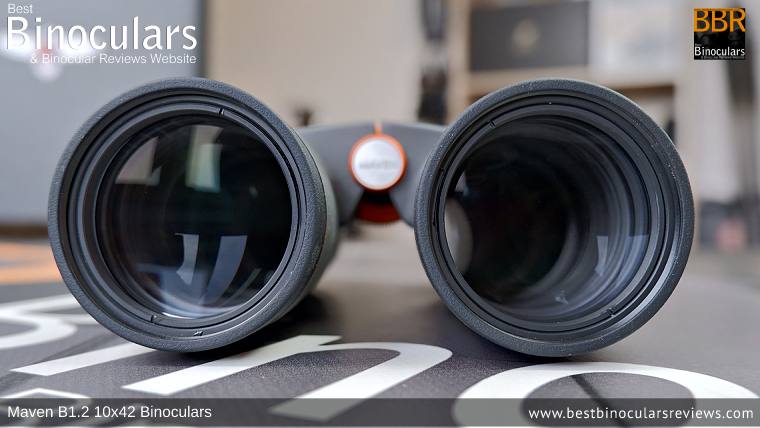
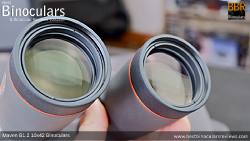 I measured the setback of the 42mm objective lenses to be about 9mm in from the ends of the barrels, which in my experience is fairly deep.
I measured the setback of the 42mm objective lenses to be about 9mm in from the ends of the barrels, which in my experience is fairly deep.
This deep position within the end of the barrels offers them more protection against things like being scratched as well as light rain and even collecting dust than those that are set closer to the ends.
ED Glass
Each objective lens is arranged into 3 groups 4 elements and whilst Maven does not include it in their name as many manufacturers do, these objective lenses on the B1.2 series do contain elements within them made from ED (extra-low dispersion ) glass.
Essentially ED glass elements give the lens designer more options when it comes to controlling the wavelengths of light as they split up going through the lens and thus they have the potential to reduce chromatic aberrations, which in turn has the potential to produce a higher definition image showing less color fringing around the edges of objects.
Here it is important to note that not all ED glass is equal and that just adding ED glass elements into a lens, does not guarantee the view will be improved. You still need the expertise to design it in such a way that it takes the whole optical pathway into account.
Take a look at the Image Quality section below to see just how well I thought these performed in this area.
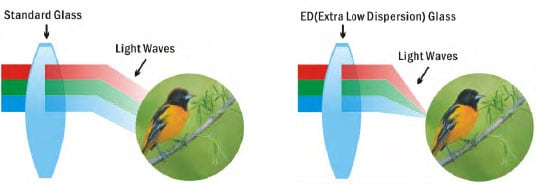
The whole series of Maven B1.2 binoculars use Schmidt Pechan design of roof prisms in order to rectify the inverted image, which has the advantage in that they enable a more lightweight, compact instrument to be made.
In the specifications sheet, Maven also adds that this updated B1.2 series uses "Wide Angle" Schmidt-Pechan prisms, which is not the case on the older B1 series models who have their "standard" Schmidt-Pechan prisms. I am not exactly sure of the difference here, but in terms of the fields of view, these updated Maven B1.2's produce a much wider view than the 10x42 B.1 binos - for more see the Optical Stats section below.
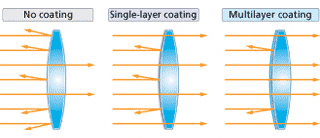 Anti-Reflection Coatings
Anti-Reflection Coatings
As you would expect from a high-end bino like these, the optical system is
Fully Multi-Coated.
When comparing binos, it is very important to take note of the exact wording in this regard as being Fully Multi-Coated confirms that there are multi-coatings of an anti-reflection material added on all air-to-glass surfaces throughout the entire optical system.
Lesser quality/ cheaper binoculars will sometimes highlight that they are Fully Coated or Multi-Coated, which sounds good, but in reality it means only some lenses are coated and then these only contain a single layer coating which makes a huge difference to both the quality and brightness of the view.
For more: What To Look For When Buying Binoculars & Anti-Reflection Lens Coatings.
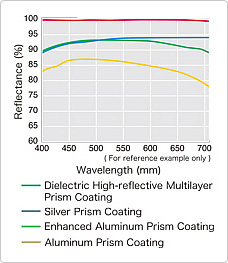 Prism Coatings
Prism Coatings
In their comprehensive specification sheet, Maven also confirms that the roof prisms have dielectric mirror coatings added to them, which is what we want to see as it ensures that more than 99% of the light gets transmitted.
Lesser quality roof prism binoculars will use silver or aluminum, which are both better than nothing at all, but certainly don't transmit anywhere near as much light as a good quality dielectrically coated roof prism.
Protective Lens Coatings
As I have already mentioned, the to objective lenses are set back nice and deeply within the ends of the barrels, which offers a good level of protection. In addition to this, the outer lens surfaces on all Maven B1.2 binoculars are further protected in that they have a coating added to them that is both scratch and oil resistant.
Whilst the scratch resistance has an obvious benefit, the oil resistant coating may not seem important. However what it does is help ensure that the lenses remain cleaner for longer (especially from finger prints if you accidently touch the lenses). They are also easier to clean when you eventually have to. This means you apply less force whilst cleaning, which in turn reduces the likelihood of you damaging or scratching the lens.
Optical Components Score: 9/10
The Field Of View (FOV)
With and angle of view of 6.6° the Maven B1.2 10x42 Binocular delivers a view that is 347ft wide/high at a distance of 1000 yards away (approx: 115m @ 1000m), which as you can see from the comparison table below is about as good as it gets for a full-sized 10x binocular.
Indeed this FOV is as wide as that which you get on many 8x42 binoculars! This is not only very impressive, but means you get the best of both worlds: A slightly higher 10x power to give you more reach / image detail, but at the same time the width of view is not compromised, which makes it easier for users like birders, hunters and general wildlife observers or anyone who needs to quickly locate and then follow moving objects. A wider view also makes it easier when scanning large areas looking for a subject.
Also just to note that this is one of the major improvements between theses and the B.1 series where the 10x42 model has a FOV of 341ft@ 1000yds, which is still good, but substantially narrower than the B1.2.
Close Focus
Here on BBR I rate a minimum focus distance of 6ft (1.8 meters) or less on a standard full sized instrument like these as being excellent.
Thus with an official near focus distance of just 4.9ft (1.5 meters), these 10x42 Maven binoculars are truly superb in this area. Obviously I did check this just to make sure and I was actually able to achieve a sharp focus on objects at an even closer distance of just 1.3 meters!
This along with their very wide FOV (for a 10x42) makes these a great option should you also like to occasionally study objects like butterflies, flowers or indeed birds from very close range.
Here again we see another large improvement on the B.1 10x42 binocular which has a respectable, but longer close focus distance of 6.6ft.
Eye-Relief:
Just like the other optical stats above, the 17.8mm of eye-relief on these Maven B1.2 Binoculars is also truly excellent. Indeed, the fact that they have such a good minimum focus and FOV, makes this even more impressive as you will often find an instrument is strong in one area and weak in the other.
Once again the B1.2 improves on the Maven B.1 10x42 binocular which has an eye-relief of 16mm.
This Long Eye-Relief combined with the excellent eyecups with their four click stops that I have already gone over makes the B1.2 a very good option if you are looking for a binocular that you can use both with and without eye glasses / eye protection.
I did check this and by fully twisting down the eyecups, I was able to take in the full image without any tunneling effect / black rings forming on the edges. For more on this, be sure to check out my guide on How To Use Binoculars With Glasses.
Optical Stats Score for a 10x42 binocular: 10/10
As with all my binocular reviews, describing, quantifying and rating the view through the binoculars is by far the hardest part, yet I am sure you would agree, it is also probably the most important!
This is mostly because not only is the image quality very subjective, but the ambient conditions are never truly the same and over time one's perception certainly changes. So to help me to be as consistent and as fair as possible, I use a number of benchmark binoculars (with the same or similar configuration) to compare and then rank the view against. So for this review, I used both my my "alpha" level 10x42 and mid-level 10x42 benchmarks and compared them all in a wide range of scenarios and light conditions:
Colors & Contrast
I felt that both the colors and level of contrast of the image looked to me to be extremely similar, if not identical to that of my alpha benchmark 10x42. The colors delivered by both instruments looked vibrant, but not by too much to make the view feel cartoonish.
Also important to mention her is that the overall tint of the image was what I would describe as neutral and true to life. Sometimes you get a view through a binocular that can have a yellow / blue tint to it.
Likewise, the variation between the dark and light areas in any given view was good. Even in very bright light, the dark shadow areas remain dark, whist in low light, the highlights still jumped out at me.
Image Brightness
As is pretty much to be expected in good light conditions during the day, I really could not observe a noticeable difference in image brightness between these and my alpha 10x42 binoculars. Under these conditions, both were to my eyes very slightly brighter than the mid-level benchmark, but this was tough to be 100% sure.
It was in sub-optimal light conditions when the difference in optical components and coating quality become more evident as both these Maven B1.2 10x42 Binoculars and the alpha benchmark more clearly outperformed the lesser quality instrument by producing a view that was notably brighter, which became more evident in the ever decreasing light as and just after the sun was setting.
So for image brightness, I rate these Maven B1.2 binoculars as truly excellent for a 10x42 binocular.
Color Fringing
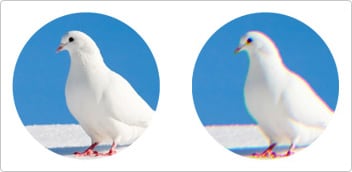 As I went over in the optical components section above, the ED glass elements that Maven adds into each of the objective lenses are primarily there to reduce chromatic aberrations, which in turn can help reduce the amount of color fringing you see in the image.
As I went over in the optical components section above, the ED glass elements that Maven adds into each of the objective lenses are primarily there to reduce chromatic aberrations, which in turn can help reduce the amount of color fringing you see in the image.
Whilst this is good, by simply using ED glass does not guarantee a good result as there are many, many other factors involved and as such I have often seen a good quality non-ED glass instrument show less color fringing in the view than a lesser quality ED glass one.
However, as the B1.2 uses high-end optics, I was expecting them to do well in this area and they did not disappoint:
Even under extreme tests like looking along the edges of a black telephone line against a bright sunlit sky, the color fringing was minimal for a 10x binocular and so once again I rate them highly in this area.
Image Distortions & Blurring
The amount of vignetting / softness right at the edges of the view is also very minimal (almost non existent) and in my experience is about as good as it gets.
Also I would like to add that at no time was I ever aware of any other undesired image distortions (like image curvature).
Conclusion
For a 10x42 binocular, I rate the overall view through these Maven B1.2 Binoculars truly superb and easily rank among the best I have used.
Score for Image Quality: 9/10
Packaging
Whilst my reviews are lengthy, it is not often that I will reflect on the packaging, but I in this instance, I feel that it is at least worth stating that the packaging has changed quite a lot from the Maven binoculars that I have reviewed in the past.
I am not sure if this change is just new for this B1.2 series or if they are using it on all their instruments. Anyway, rather than me trying to describe this new greener "egg box" design, you can take a look at my unboxing video below:
Carry Bag
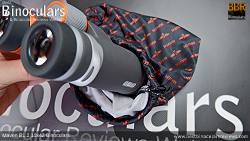 As was the case when I reviewed the Maven B2 and B5 binoculars, these B1.2's are not supplied with a "normal" carry case.
As was the case when I reviewed the Maven B2 and B5 binoculars, these B1.2's are not supplied with a "normal" carry case.
Instead the Maven Optics includes a soft drawstring carry bag made from a fine material that is double-layered and comes with a microfiber interior similar to that used on most cleaning cloths.
For users like me who usually don't take the case out into the field or those who use a binocular harness, this solution actually works very well, but there will be some that may be disappointed by this.
Note that in terms of the accessories score, I have had to mark Maven down here because my scores are relative and thus in comparison to most other bins, the bag they supply is excellent but is still inferior to most normal cases.
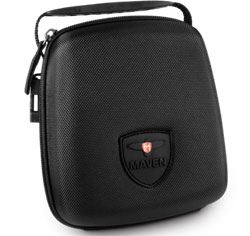 Optional Maven Binocular Case:
Optional Maven Binocular Case:
Note that if you do need or want a carry case for your binos, then you can buy the Maven one as an optional extra. They currently cost around $20, which from the photos, do look to have a semi-rigid design and seem to be well made.
However other than that I can't comment much more as I have not seen or used it myself.
Neck Strap
As has always been my experience with Maven binos, the included neckstrap is excellent and makes carrying your instrument about as hassle free and comfortable as you could ask for.
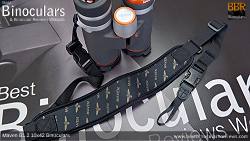 Made from a slightly elasticated material (probably Neoprene) and then covered in a fine material, the padded section is quite wide (5.2cm) as well as thick (6mm) and thus not only spreads out the load, but also offers plenty of padding which I feel is more than enough for these fairly lightweight 42mm binos.
Made from a slightly elasticated material (probably Neoprene) and then covered in a fine material, the padded section is quite wide (5.2cm) as well as thick (6mm) and thus not only spreads out the load, but also offers plenty of padding which I feel is more than enough for these fairly lightweight 42mm binos.
I also like that this padded section is slightly curved and thus fits around your neck and shoulders more naturally.
The only slight issue I have with this section is that the underside is smoother and thus offers less grip some, meaning that it could be more susceptible to sliding about as you walk.
I do really like the non-typical way the strap attaches to the instrument: After un-clicking it from the rest of the strap with the quick release clips (which are excellent), you simply and very quickly loop the thin cord back through itself after you have passed it through the eyelet located on the side of the binocular's body.
For someone like me who has to attach many straps to many binoculars, I do appreciate how much easier and less time consuming this is than the normal method of using sliders.
Whilst this is quick and easy, things only get better because the quick-release clips mean that removing or replacing your neck strap literally only takes a couple of seconds. These clips also makes it possible to easily attach the bino onto a bino harness and swap between the two very easy as well.
Lens Covers
Whilst they fit onto the barrels well and function well enough, compared to things like the focus wheel or the neck strap, the lens covers do lack a little in terms of finesse, look a little generic and certainly do not add to the binocular in terms of their looks.
I feel that the objective lens covers could easily be improved if they had designed them to fit into the ends of the barrels instead of over them and perhaps were to add their logo, which would make them look to be more apart of the package as a whole and less of an afterthought.
Having said that, a good aspect to these covers is the rubber Maven uses is a little thicker and looks tougher than most, this is especially important at the crease where the cover connects to the loop that goes around the barrel as this is a point that often breaks.
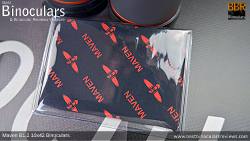 Cleaning Cloth
Cleaning Cloth
As well as the carry bag than can be used to clean the instrument, Maven now also supplies the B1.2 with an excellent micro-fiber cleaning cloth that is as good as any that I have seen.
This is great for use when out in the field, but as always, for more complete and safe cleaning of the lenses, I suggest you use a dedicated lens cleaning kit.
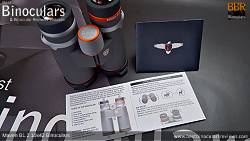 Instruction Booklet
Instruction Booklet
Packaged in it's own maven branded envelope, the included booklet is fairly comprehensive and certainly far better than most I come across. It covers all the basics needed including details on all the parts of the instrument, IPD distance adjustment, eye-relief, diopter adjustment (very important!), strap connection, using the binoculars with a tripod, cleaning and details on the warranty:
Lifetime Warranty
As with all Maven binoculars, the B1.2 is protected by their an unconditional lifetime warranty which is not only reassuring, but truly demonstrates the faith they have in their products.
Accessories Score: 8/10
From the table below, you can compare some of the details of these Maven binoculars against a small selection of other High-End ($500-$1200 / £500-£1200) 10x42 binoculars in the BBR database.
Open table in full-screen mode to view the full results.
The use of very high-quality Japanese components and optics, combined with the obvious attention to detail shown by Maven during the assembly process in the USA comes together to deliver an instrument that I believe is just about as good as you could wish for at this price range.
Smaller, more lightweight, with improved optics, a much wider field of view, longer eye-relief, a closer minimum focus distance... if you take into account all the improvements that Maven has made in updating the B.1 series without increasing the cost, then it is for me easy to state these Maven B1.2 10x42 binoculars have an excellent performance to price ratio and compete very well with many far more expensive instruments currently on the market and thus I have no hesitation in highly recommending them.
Optical Components and Image Quality
The Maven B1.2's use very high-end glass and top quality optical coatings that in this case directly translates to a superior overall image quality that is also very bright for a 10x42 binocular. I also really like that they have very large ocular lenses, which offer a number of advantages including making it easier to line your eyes up with.
Components Used & Build Quality
From the magnesium chassis to the all metal eye-piece housings and focus wheel, the very high level of components used, general build quality and great attention to detail is evident wherever you look on the Maven B1.2 binoculars.
Focus Wheel
For me it is simply the best focus wheel you will find on a binocular as not only does it look great, but is extremely well made and thought out with a focus action that is super silky smooth.
Field of View
For a 10x powered instrument, these Maven B1.2 10x42 Binoculars have
an extremely wide field of view. Indeed at 347ft@1000yds, they are at the time of writing deliver one of the widest views I have ever seen on a 10x roof prism binocular.
Close Focus
As with the field of view, the minimum focus distance of just 4.9ft matches that of the very best in this area: for example the Swarovski 10x42 EL.
Eye-Relief
At 17.8mm, the Maven B1.2 10x42 Binocular has plenty of eye-relief, which along with the excellent 4 position click-stop eye-cups makes them a good option should you want or need to use glasses or eye protection whilst binning.
Size & Weight
For a high-end, mostly metal binocular using top quality optics, the new Maven B1.2 is not only smaller and substantially more lightweight than the older B1, but compares extremely well against other instruments in this price/quality range.
Diopter
A lockable diopter would have been a nice touch, but having said that the metal ring that Maven uses is fairly inconspicuous and tight enough to prevent most unwanted movement from occurring
Carry Bag
Whilst it is possible to buy one separately, for some users the lack of an included carry case may be an issue, so I have to add it as a weakness as most other manufacturers will include one. However, for many the included carry bag that can also double as a cleaning cloth will be sufficient, especially if you plan on using a bino harness and thus they will be happy that Maven has decided to spend that money saved elsewhere on the instrument.
Lens Covers
Whilst the objective lens covers work as well as you would like and I like that they are made from a thick rubber and thus will probably be longer lasting than most, the look of them just does not quite match the very high standard set by the rest of the binocular and it's accessories and I just wish Maven would make something that looked less generic and possibly fitted into the ends of the barrels and not over them. Once again and as with the case, if you plan on using a bino harness, you may end up completely removing the covers and so this won't matter to you at all.
Ideal Uses
Reviewed by Jason Whitehead for Best Binocular Reviews
|
 Awards:
Awards:Best Binoculars 2024 (Under $1000 / £1000 / €)
Main Specifications & Features:

Below are similar pairs of Binoculars that you may also want to have a look at:
Extremely high quality components combined with a high level of expertise results in an alpha level binocular at a sub alpha price.

General Price Range: (5/6) High Value Binoculars
Below is a link that will take you to a page with online retailers in both the US and UK that sell Maven 10x42 B1.2 Binoculars this page makes it easy to compare prices and then to buy from your preferred option:
|
Buy & Compare Prices for the Maven 10x42 B1.2 Binoculars |
||
US Shoppers |
Canadian Shoppers |
UK Shoppers |
Deutsch Shoppers |
Aussie Shoppers |
Indian Shoppers |